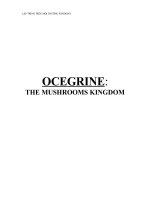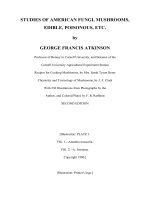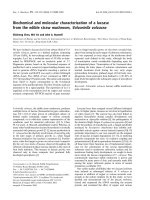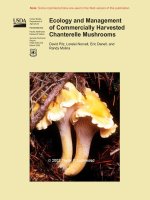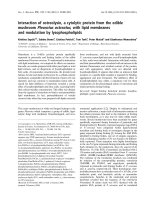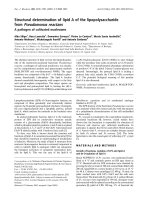edible mushrooms
Bạn đang xem bản rút gọn của tài liệu. Xem và tải ngay bản đầy đủ của tài liệu tại đây (1.84 MB, 23 trang )
<span class='text_page_counter'>(1)</span><div class='page_container' data-page=1>
Hello everyone!
Welcome to our
</div>
<span class='text_page_counter'>(2)</span><div class='page_container' data-page=2></div>
<span class='text_page_counter'>(3)</span><div class='page_container' data-page=3></div>
<span class='text_page_counter'>(4)</span><div class='page_container' data-page=4>
<b>Kingdom fungi</b>
:
Over 1.5 million species
Edible mushrooms: many thousands of
known species
</div>
<span class='text_page_counter'>(5)</span><div class='page_container' data-page=5>
Outlines
Our presentation is divided into 5 parts:
• Part 1: Introduction.
• Part 2: Benefits from edible mushrooms.
• Part 3: The growth of edible mushrooms.
• Part 4: Identifying poisonous and edible
mushrooms.
</div>
<span class='text_page_counter'>(6)</span><div class='page_container' data-page=6>
<i>Part 1</i>
: Introduction
•
<b>Definition: </b>
- Edible mushrooms are the fleshy and edible fruiting bodies of
several species of fungi.
- Belong to the macrofungi.
•
<b><sub>Characteristics</sub></b>
: bring the common characteristics of the
fungi:
- Eukaryote
- Multicellular
- No chloroplast
- Heterotrophic
- Cell wall: chitin
</div>
<span class='text_page_counter'>(7)</span><div class='page_container' data-page=7></div>
<span class='text_page_counter'>(8)</span><div class='page_container' data-page=8></div>
<span class='text_page_counter'>(9)</span><div class='page_container' data-page=9></div>
<span class='text_page_counter'>(10)</span><div class='page_container' data-page=10>
<i>Part 2</i>
: Benefits from edible
mushrooms
<b>1. Nutrient values</b>
They typically contain:
•
90-95% water (when fresh)
•
<sub>5% carbohydrates</sub>
•
<sub>5% protein </sub>
</div>
<span class='text_page_counter'>(11)</span><div class='page_container' data-page=11>
<b>2.Benefits from edible mushrooms</b>
• Lose weight, keep body weight in balance.
• Control blood pressure, Cholesterol.
• Combat cancer
• Protect cells from damaging effects
• Salubrious and good for digestion.
• Against infection
• Stop migraine
</div>
<span class='text_page_counter'>(12)</span><div class='page_container' data-page=12></div>
<span class='text_page_counter'>(13)</span><div class='page_container' data-page=13>
<i>Part 3</i>
: The growth of Edible
mushrooms
• The growth is hidden in the
ground.
• The spawn is made up of a
multitude of growing cells.
• It continues to grow from
</div>
<span class='text_page_counter'>(14)</span><div class='page_container' data-page=14></div>
<span class='text_page_counter'>(15)</span><div class='page_container' data-page=15>
<i>Part 4</i>
: Identifying
Poisonous and edible mushrooms
The difference between edible and non-edible
mushrooms is the toxins that are present in the
poisonous mushrooms.
•
<i><sub>Poisonous mushroom contain organic toxins that </sub></i>
<i>destroy cells in the central nervous system, </i>
<i>blood vessels, kidneys and liver.</i>
</div>
<span class='text_page_counter'>(16)</span><div class='page_container' data-page=16></div>
<span class='text_page_counter'>(17)</span><div class='page_container' data-page=17>
How to identify edible mushroom?
• Many kinds of edible
mushrooms like
</div>
<span class='text_page_counter'>(18)</span><div class='page_container' data-page=18>
<i>Each species must be carefully </i>
<i>studied and learned</i>
•
<i>Some characteristics </i>
<i>can determine </i>
<i>poisonous mushroom.</i>
<i><sub>Color: sometime red </sub></i>
<i>or yellow</i>
<i><sub>Grooves, cracks</sub></i>
<i><sub>Pungent smell</sub></i>
</div>
<span class='text_page_counter'>(19)</span><div class='page_container' data-page=19>
<i>Part 5</i>
: Diversity of edible
mushrooms
•
<i><sub>Habitats</sub></i>
: grow in a wide range of habitats,
including extreme environments such as deserts, or
areas with high salt concentrations or ionizing
radiation, as well as in deep sea sediments.
•
<i><sub>Shapes</sub></i>
: Crown Coral, King Trumpet Mushroom,
Pear-shaped Puffball, Hexagonal-pored Polypore…
</div>
<span class='text_page_counter'>(20)</span><div class='page_container' data-page=20>
<b>PUFFBALLS </b>
•Where: On soil or decaying wood.
•When :Late summer and fall
•Description:- shape: round or pear-shaped
- the interior: solid white, yellow, brown,
finally dark
</div>
<span class='text_page_counter'>(21)</span><div class='page_container' data-page=21>
<b>Bearded Tooth (</b><i><b>Hericium erinaceus)</b></i>
•Where: Always on trees, logs or stumps.
•When :Summer and fall
•Description:- shape: a polar bear's paw
- the interior: pure white,
but yellows with age
<b>Oyster Mushroom </b><i><b>(Pleurotus ostreatus)</b></i>
•Where: On trees and fallen logs.
•When :Spring, summer, fall and during
warm spells in winter
</div>
<span class='text_page_counter'>(22)</span><div class='page_container' data-page=22></div>
<span class='text_page_counter'>(23)</span><div class='page_container' data-page=23></div>
<!--links-->
